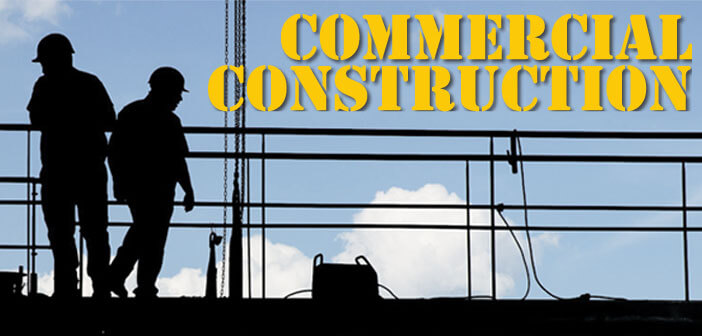Commercial Construction in Omaha, NE 2017
Commercial construction is one of the key indicators of a thriving city and economy; it’s a sign that business is good, and the market supports such a major investment into growth. Omaha is a city that has enjoyed steady growth, along with the other cities in the Metro area, and this is projected to remain true again in 2017 as construction season is about to begin.
So without further ado, let’s get into all of the things that would likely be on the radar of those who are considering embarking on a commercial construction project. There are many different types of companies that might be involved at different points in the project timeline, all with professionals who bring something different to the table with unique skill sets, experience, and offerings.
Project Financing
Before you get on the books with the professionals for the design-build process, first you’ll be getting financing in place for the project with the help of a trusted financial professional.
“As a lender, it is our job to assist the borrower in determining the structure that works best for the type of property being built,” advises OJ Spooner of Centris Federal Credit Union. “In some cases, it is to position the borrower to take advantage of long-term financing programs once construction is complete and the property is occupied. Lenders add value by coordinating the appraisal, title insurance and survey process that is needed to determine the loan amount and ensure that title is clear of all liens and other encumbrances and all easements are identified prior to the commencement of construction. Once the loan is closed, the lender is responsible for administering the disbursement process, which means working with the borrower and title company to ensure funds are available and the project is free of any mechanics liens.
You’ll want to keep in mind that interest rate by historical comparisons remains low, however land prices more than offset gains achieved by the lower interest rates. Nonetheless, there is a very active commercial construction market here in the Omaha area.”
Spooner offers the following tips:
- Ensure that you understand your lender’s process and procedures when seeking loan approval and for handling disbursements.
- Take time to determine the best type of long-term financing you want to obtain when construction is completed and position your project accordingly.
- Be prepared to financially meet cash equity requirements.
- Establish interest reserves to allow time for construction, lease up so that there will be sufficient cash flow to service the debt.
- Ensure you have a contingency built into your budget. This will allow for those unforeseen circumstances that are bound to occur during the course of construction.
He concludes, “Speak to your lender early in the process and determine the lender capabilities and what you, as the borrower, will need to do to obtain approval and close on a commercial construction loan. Be prepared to provide tax returns and personal financial statements, plans and specs, construction budgets and projections and more. Borrowers will want to understand how much equity the lender is requiring and will want to identify what can be included as equity, such as land or other pre-paid soft costs. Most of the time, the borrower will be required to inject equity before the lender will fund the loan.”
Architect & General Contractor
This is the first of many things to come that will involve a major decision on the part of the business owner/investor. You’ll want to choose your architect and/or general contractor wisely, because their level of experience and the established network of subcontractors they’ve chosen to partner with for projects will make all the difference in the outcome of yours.
Your general contractor, in particular, is the professional that will be responsible for bringing the vision and dream to life for the owner of the new property, which isn’t something to be not something to be taken lightly. Most people will only be involved with one or two major construction projects in their life, so by working with someone who has many under their belt, you’ll benefit from experience that you’d never come remotely come close to yourself. The general contractor is tasked with project management—they are the ones at the center of everything who handle all aspects accordingly.
Prior to the general contractor’s role, it’s common to work with an architect to put together a design. You’ll want to interview several before committing to one. Pick someone that you can easily work with and who will allow you to be involved with the design process. Be very detailed about the design, because changes that become necessary or are wanted later in the project cost much more than if they were incorporated into the initial design.
Next, it’s helpful to be aware that there are a few different contract methods when dealing with general contractors. These are generally design-bid-build, design-build, and construction management. Educate yourself on these different methods, and the one you are most comfortable with should be your choice moving forward.
Metal Buildings
You’ve seen them go up all around town; for commercial space, pre-engineered metal buildings have become very popular in recent years. It’s seen as an attractive option for industrial purposes or for someone who is on a shorter timeline, but does not exclude any type of business as these can be designed for just about any use one could envision. You’ll find that flexibility is important with any offering in the construction industry, with this being a key example.
Local companies with the erection of metal buildings as a part of their offerings generally are able to provide design-build services, followed by certified installation and project management throughout the entire process. Working with one company on a project is nice because you have one point of contact for anything within the scope of that entire project, and one party who is responsible for delivering the results as promised, on time and on budget.
“As a general contractor specializing in all-steel pre-engineered buildings, we offer a wide array of quality features and optional accessories to improve functionality and enhance your building’s appearance,” says Darren Kinney of Talon Steel Buildings. “Talon Steel buildings come standard with heavy-duty 26-gauge roof and wall panels, available in a Bare, Siliconized Polyester (better), or Kynar (best) finish. Panels come in a variety of profiles, colors, and warranty options that offer outstanding beauty and long-term protection. We can add any kind of window you want, and do have an inexpensive starting point that doesn’t sacrifice quality. Finishing the inside of your building with steel liner panels adds style and energy efficiency. Then, whether you need just a simple access door or multiple loading/equipment bays, Talon’s wide range of insulated and non-insulated door types and styles can be sized and configured to your exact specifications. If you would like a hydraulic lift overhead door, that’s a possibility too!
Finally, it’s advised to protect your foundation and property from erosion and water damage while beautifying your structure, and we have great options for overhangs, gutters, and downspouts. Made from light gauge materials and available in many attractive trim colors, these systems are hemmed for a strong, smooth and corrosion-resistant edge for years of the functionality. We feel that it’s important for our clients to have options, so with every aspect of the building, you can pick exactly what fits your needs and budget.”
Parking Structures
With new construction for commercial space often comes the need for new construction to accommodate parking, whether it’s a garage or lot.
When it comes to any project where concrete and/or masonry are involved, it’s important to work with those who have plenty of experience with these specific materials. Here in Nebraska, the changes in weather can be quite drastic, and this is a frequent phenomenon that happens year-round. In just one week, we can go through all four seasons, from windy and cool to snow, shifting suddenly to a sunny and calm 60-plus degrees, then back to rain and freezing into ice. Considering that exact thing just happened, although maybe not in that specific order, let’s just say it’s not at all uncommon.
The problem with these types of unpredictable weather patterns is that it causes the continuous expansion and contraction of the primary materials commonly utilized in commercial construction, with freeze-thaw cycles causing degradation over time.
So, if your commercial construction plans include any type of masonry, or you’re constructing a parking structure connected or in proximity to your building, there are a couple things you can – and by all accounts, should – do early on to ensure the stability of the structure over time.
“Protection of critical areas of the structure that are exposed to the elements or responsible for its continued stability is key,” advises Dennis Rice of McGill Restoration. “You need to consult with the professionals on the construction of the building itself, that’s apparent, but don‘t overlook assessing the protection of that investment from ground zero. Concrete in particular is susceptible to deterioration and delamination over time, so you can and should expect that to happen, but slowing it down significantly is entirely possible with sealants and other protective coatings.
Many people find it hard to invest money in the things that cannot be seen, and I’ll caution you that most of the things that are done to protect your building fall into that category. While it’s not as sexy as some of the other components of your new building and space to conduct business, it’s definitely not something you’ll regret putting more money towards up-front later on down the line, that’s for sure. With our weather in the Midwest, even a brand new building might experience things within the first year’s progression of seasons that could become problematic over time. For commercial construction jobs, low bids can be attractive given the amount of money involved in this type of transaction, but might not include important items such as a urethane layer to protect the ceiling of a parking garage. Similarly, if costs need to be cut at some point before or during the project, protective elements shouldn’t be sacrificed if at all possible. You might think you’re saving money now, but you’ll subsequently be spending more down the line in repairs, and sooner than you might think. Not only is it likely to be costly, but also dangerous. Being a proactive building owner is advised across the board, and along the same lines of protecting your investment, it’s the best course of action to get a solid maintenance plan in place right away after construction is completed.”
Major Systems
Your building will be composed of many key systems working together in unison to meet the needs of its inhabitants. Meeting basic requirements as far as shelter, electricity, water, connectivity, safety, and the like may not be as appealing as the overall design, the fun extras to add, or the exciting new capabilities you’ll have once your new building is complete. Although these are things from which enjoyment and satisfaction aren’t necessarily derived, they are responsible for all of the functions that will keep you up and running and able to conduct business without any interruptions or costly setbacks.
Roofing
Since the roof is what protects everything of value inside your business, you’ll want to be sure you’re installing a system that performs up to the highest standards, with materials used that stand up to the test of time and the elements. With every major system, you’ll also find that there are options for efficiency and energy savings, and capitalizing on those whenever and wherever you can is advised. This is definitely as true for roofing as it is for all of the others we’ll subsequently cover.
“At The Secure Roof Solution, we specialize in educating building owners and commercial roofing contractors on the energy saving roofing systems available today that offer extended life and significant energy savings,” says Dennis Nun of Heartland International, an independent manufacturer’s representative for Conklin Company, Inc. “They are now widely available, and the advantages are numerous. Energy efficient roofing systems can actually pay for themselves in energy savings and significant reductions in roof expenses in the future.
The advice I’d offer to someone who is planning to build is to take the time to research the advances in roofing, and to then select the systems and contractors you work with carefully. An energy saving roof that offers a long-term solution to your new building’s needs is a great investment, but selecting the wrong system or the wrong contractor can create a nightmare for the building owner. After 40 years in the commercial roofing industry, I think I’ve seen it all. Yet I still meet building owners who didn’t do their due diligence in advance of spending hundreds of thousands of dollars or hiring a contractor that’s inexperienced or unreliable.”
Entrances
In the view of the general public, a door can simply be a passage into a building, and yet to professionals, there are many more variables that are needed to develop the full capabilities of any entrance. For commercial businesses, the ideal doors may be a single swing or double swing doors while for others, you may be looking for an automatic sliding door, automatic swing door, or revolving doors all while maintaining compliance with the American Disabilities Act.
In any case, a team that specializes in commercial doors will be needed to assist you with your decision as it is often times not as transparent as it may seem. These entrances have many elements to them and all components affect your decision-making process when it comes to installing an automatic door. These factors include the entrance way being responsible for safety, security, and energy efficiency of the building among many other aspects. All of these options and more are available through the professionals at A United Automatic Doors & Glass and its newly formed security division, Secure Card Readers and More (S.C.R.A.M.). It is important to work with experts on the integration of all critical components, to illustrate an entryway designed specifically for you and your building.
Lighting & Power
Of the many subcontractors that will play a crucial role in a commercial construction project, an electrician is one that you can expect be heavily involved throughout, from design to installation. This is a professional who will be instrumental in establishing an infrastructure that supports the core functions of a business, from the interior and exterior lighting to outlet placement to safely wiring the entire building in a way that allows for handling loads suitable for the building’s operational systems and technology use.
Of all the important things that will be determined by the electrical grid and foundation of your building, lighting is at the top of the list. Exterior lighting will help to ensure the safety of your employees and customers, doubling as a theft deterrent by illuminating areas that are most susceptible to unauthorized entry, and can also be used to enhance the design features of the structure and potentially the landscaping too. Interior lighting is what will make the space a work environment that’s conducive to productivity, and will factor into its overall design and ambiance as far as aesthetics.
Water
You’ve probably made note of the fact that energy efficiency and environmentally-friendly practices are recurring themes within the topic of commercial construction. Moving on through to another critical utility, water usage is also something to consider when you’re installing new systems and features of the building itself, and across the entire property as a whole.
This will entail the plumbing and main equipment installed on the inside as well as the irrigation system on the outside.
Curb appeal is a big deal as far as a business’s reputation and ability to attract customers just based on first impressions alone. As such, after the building is constructed, and areas from parking to entry are complete, landscaping is generally next on the to-do list. Hand-in-hand with establishing said landscape is the installation of an irrigation system to keep it alive and thriving, protecting what’s likely to be a significant investment in the property and part of its continued maintenance.
In short, the irrigation systems of today are not remotely akin to the irrigation systems our parents had installed at their homes and businesses. Commercial outdoor water use in the United States accounts for more than 9 billion gallons of water each day, used mainly for lawn and landscape irrigation. Experts estimate that as much as 50 percent of this water is wasted due to overwatering caused by inefficiencies in irrigation methods and systems, and at a major cost to property owners as well as the environment. Irrigation control technologies can significantly reduce overwatering by applying water when and where the turf and plants require it. Advancements in irrigation range from web-based interactive controllers to pressure regulated sprinkler heads and sub-surface irrigation that offers direct delivery of water to the turf’s roots with no working parts to ever fail.
Technology
There are a whole slew of impressive options for cutting-edge technology that can be integrated into a commercial building during the initial construction phase. Control of a building’s systems, in particular, is an area where offerings, and the potential they have to positively impact a commercial building and the business inside, have been steadily developing to address the needs of building owners.
“There is now a great demand for energy efficient buildings, high-tech devices and enhanced security systems that are now central components of building management systems (BMS),” advises Pat Killeen of Engineered Controls. “BMS provide efficient control of internal comfort conditions, effective use of energy, and quick and effective responses to HVAC and security problems that save both time and money. These systems also provide information on problems in the building, allow for computerized maintenance scheduling, are easy and effective for employees to use, and easily detect problems.
By integrating HVAC, lighting and security functions all within one common BMS platform, a building’s power systems; lighting and illumination; electric power and control; security, video surveillance and magnetic card access; heating, ventilation and air-conditioning systems will all be monitored and controlled from one central location. Studies show that by 2018, it will be the integrated control systems that will show the greatest growth in future years.
Although hardwired building management systems have been around since the late seventies, it will be the wireless technology will continue to revolutionize building automation system market forward in 2017 and beyond.”
He also offers the following advice: “First, I would tell clients interested in adding building control technology to do their research. There is plenty of information on the internet today that will make the average building owner much more knowledgeable about what is available in the commercial construction market than anyone realizes.
Next, I would suggest that building owners need to get to know the consulting engineers that are designing their buildings. It is crucial for building owners to participate in the design process and to be smart buyers. Since the new construction industry consists of architects, consulting engineers, general contractors, mechanical contractors, and so on, many of the basic decisions that are being made regarding system type, configuration, manufacturer, functionality, etc. are all being made by everyone EXCEPT the customer.
Far too often we see building owners moving into a new building only to find out that they did not get that they wanted. Or occasionally the BMS system is too complicated for them to operate. So the moral of the story is to get involved, ask questions, know what you want, and know what you are getting BEFORE the decisions are made by everyone but you, the customer.”
Safety
You’ll need to ensure that your new building is designed to be up to current code and compliant with all OSHA regulations and laws in place. Putting the right safety systems in place is a big part of that for any business; whether a restaurant, warehouse, or office building, there will be different things you’ll need to take into consideration, although quality and function will remain constants for all. You are not only protecting your investment in the property, you are protecting the lives of your employees and clients.
“FireGuard eliminates the need to contact multiple companies by offering complete life safety solutions,” advises Bob Sorensen of FireGuard. “We design, sell, install, inspect, and service all types of fire protection and life safety equipment. All new construction commercial-use buildings will have a need for these types of systems, so my advice is to involve the professional that will be tasked with the installation of the system(s) you require as early on in the design-build process as possible. By having this incorporated into the plans early on, you’ll ensure that everything goes smoothly down the line during construction and that you have exactly what you need in place to get up and running on schedule.”
Finishing Touches
Once the building itself is complete, it then will undergo a transformation on the inside to become your office, shop, boutique, salon, restaurant, showroom, etc. From the flooring and paint to cabinets and finishes to furniture and décor, the potential here is limitless. Working with a professional interior designer is advised, as well as the design team at any of the vendors you’ll use for the different features. The quality of materials is imperative because durability and longevity are they key to getting the most out of your investment. Using tile as an example, larger tiles in a quality porcelain material have gained popularity because of their attractiveness and durability, and larger floor mat tiles, plank tiling, faux wood, and other scratch-resistant finishes remain on trend for the same reasons. It’s worth paying an extra dollar or two per square foot for a finished product that will look much better as well as having a longer life before replacement is needed. A professional will be able to guide you as to the pros and cons of the various materials you’re thinking about incorporating to ensure you’re making an educated decision. For tile, check out Ceramic Tileworks Center for materials and Modern Concepts Tile for installation, you’ll be in great hands. Again, you get what you pay for, and the appearance of your place of business, inside and out, and the environment you’re able to create is part of your brand signature and an extension of your reputation. The impression it makes on your customers and those who are considering doing business with you in the future, and the effect it has on your employees, are not to be underestimated.
Tools of the Trade
While our focus thus far has been on the consumer who is building, within the trades there’s always something new to learn or new tools to implement for the benefit of all. As is the case equipment that takes into account safety, a major concern for construction workers.
“Midwest Woodworkers isn’t well known for offering construction tools, but we have one product that every construction company should know about,” advises Gerry Phelan with Midwest Woodworkers. “The SawStop jobsite table saw is the first portable saw that truly takes table saw safety to the next level. It won’t cut fingers. The patented SawStop system stops and retracts the blade at the first contact with skin, faster than an airbag.
Here’s how it works: The blade carries a small electrical signal. When skin contacts the blade, the signal changes because the human body is conductive. The change to the signal activates the safety system and an aluminum brake springs into the spinning blade, stopping it. The blade’s angular momentum drives it beneath the table, removing the risk of subsequent contact. All that happens in less than 5 milliseconds! The result is a minor nick rather than a severe injury or amputation. If the brake system is triggered there is no damage to the saw. You replace the blade and the brake cartridge and in as little as 5 minutes you can be back in operation.
There is a table saw accident in the United States every 9 minutes on average. There are 10 amputations every day. The societal cost of these injuries is in the billions of dollars, and the impact on victims cannot be counted. The initial investment for a SawStop Jobsite saw is $1299.00. If you think that sounds expensive, compare that investment in safety to the cost of an emergency room visit, or worse, an amputation. It’s a bargain. And the best part is that there is no need to compromise on performance. This saw matches the power of similar 1.5HP jobsite saws and it has features not found on other saws in its class. It’s an awesome tool AND it keeps employees safe.
We hate to see companies come to us for a SawStop after they’ve had an incident. That usually means someone was hurt. We’d rather be proactive and keep those accidents from happening. If SawStop’s capabilities seem hard to believe, Midwest Woodworkers can bring a saw out and provide a demonstration.”
He adds, “Because of our focus on table saw safety, we’ve also developed a series of safety briefings on woodworking tools. It’s difficult for organizations to find new ways to make safety meaningful and relevant to their employees in safety meetings. We can provide solid, focused table saw safety content that makes safety real and memorable. And we can even bring a SawStop Jobsite Saw along and do the famous ‘hot dog’ demo. With everything I’ve detailed, we hope to have a huge impact on safety in commercial construction worksites.”
Companies may also need to rent various pieces of equipment to perform certain jobs. No matter the task, Honeyman Rent-All can provide any equipment that you might need for your commercial construction project. Troy Honeyman of Honeyman Rent-All, says, “Many times on the job, you might need something that you don’t own or have on-hand. That is where we can be of assistance, as we have a wealth of equipment and tools that are available for rental and our staff is on-hand six days a week to help you find exactly what you need to complete the job successfully. We also make sure that you fully understand how to operate each piece of equipment that you rent and we provide hands-on service. At Honeyman Rent-All we take pride in our extensive rental inventory which includes a wide variety of equipment for specialized projects such as demolition, concrete, drills and attachments, drywall and wallpaper, electric hand tools, floor and carpet, landscaping, generators and welders, hoists, jacks, ladders, lifts, lighting and electrical, measuring and locating, painting, plumbing, pumps and hoses, saws, tractors and trailers, trenchers and skid steers, climate control, cutters, and air equipment. We look forward to working with you to ensure that you have the right equipment and tools for the job so that you can bring your project to life!”
There you have it, all that you ever wanted to know about taking on your own commercial construction project here in Omaha…and probably more! It’s a booming industry, and we’ve got great companies doing great things here to build our great city. Should you be part of the excitement in the future, make sure to utilize the expertise of the professionals to get it done to the highest standard of quality and performance.








